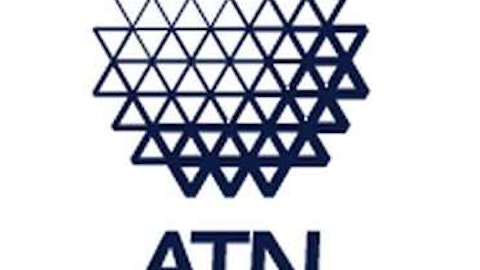ATN International, Inc. (NASDAQ:ATNI) Q3 2023 Earnings Call Transcript October 26, 2023
Operator: Good day, and thank you for standing by. Welcome to the ATN International Q3 2023 Earnings Conference Call and Webcast. At this time all participants are in a listen-only mode. [Operator Instructions] Please be advised that today’s conference is being recorded. I would now like to hand the conference over to your first speaker today, Justin Benincasa, CFO. Please go ahead.
Justin Benincasa: Thank you, Kathy, and good morning, everyone. This morning, we’ll be review our third quarter 2023 results. I’m joined by Michael Prior, ATN’s Chief Executive Officer; and by Brad Martin, our Chief Operating Officer. Michael will provide an update on the business and strategy and a high-level overview of our quarterly results. I’ll cover our financials and provide additional color where necessary, and Brad is here for questions-and-answer session. As a reminder, we released our third quarter results press release yesterday afternoon after the market closed. Investors can find earnings – earnings release and results presentation on our Investor Relations website. Our earnings release and the presentation contain forward-looking statements concerning our current expectations, objectives and underlying assumptions regarding our future operating results.
These statements are subject to risks and uncertainties that could cause actual results to differ materially from those described. Also, in an effort to provide useful information to investors, our comments today include non-GAAP financial measures. For details on these measures and reconciliations to comparable GAAP measures and for further information regarding the factors that may affect our future operating results, please refer to our earnings release on our website at atni.com or the 8-K filing provided to the SEC. I’ll now turn the call over to Michael for his prepared remarks.
Michael Prior: Thank you, Justin. Good morning, everyone, and thank you for joining us. We’re pleased with our third quarter performance as we continue to rapidly convert customers to our high-speed networks and work towards completing our three-year plan at the end of 2024. Let me start by sharing three key takeaways from our performance. First, we continue to execute well on all fronts, delivering higher revenue and EBITDA on solid subscriber growth in both the quarter and first nine months of 2023. Second, the infrastructure investments we’ve made in building out our broadband network provides the foundation for strong recurring revenues, durable discretionary cash flow and long-term shareholder value. And third, as we approach the final year of our three-year plan, we remain committed to managing our balance sheet and spending levels to maximize free cash flow over time.
So we launched our ambitious Glass and Steel and First-to-Fiber platform strategy two years ago, accelerating the delivery of high-speed data services to underserved consumers and businesses, primarily in rural areas. And reflecting on our third quarter and year-to-date results in the context of that plan, I’m proud of the financial and operational milestones our team has accomplished towards those objectives. Justin will provide an update on our financial results, but I’ll begin with our operating metrics. We achieved robust high-speed broadband subscriber growth of 20% year-on-year, highlighted by strong contributions from our international markets. Additionally, our international markets saw a 13% annual increase in mobile subscribers.
In the U.S., we continue to expand our network reach to high-speed data subscribers and to enterprise and government customers. At the same time, we are making progress on rationalizing our legacy network and reducing run rate operating costs. We recently were recipients or sub recipients of nearly $45 million in federal grants to connect people in underserved rural and tribal areas to high-speed internet networks. These program grants follow on the more than $155 million in grants awarded to us and our partners over the previous 12 months and will subsidize the funding for fiber and fixed wireless high-speed network expansion in rural areas of the United States, including parts of Alaska, Arizona, Nevada and New Mexico. The network builds funded by these and potential additional brands are likely to extend over the next several years, paving the way for us to expand our network reach and grow our customer and revenue base, even as the pace of our self-funded capital expenditures decreased as planned.
And for those of you who are new to ATN, we derive about half of our revenue from customers in the U.S., principally from rural communities in the west and southwest and both urban and rural areas of Alaska. The other half of our revenue comes from Bermuda and the Caribbean, following to some fast-growing markets like Guyana. We’re seeing strong mobile subscriber growth and a rapid uptake of high-speed broadband. Based on the positive dynamics and our approach to maximizing the long-term value of our capital investments, we are encouraged about the opportunities across our markets in the quarters and years ahead. ATN is all about high-speed data connections. We play directly into what is unquestionably one of the world’s most durable secular growth drivers, the need to be connected anytime and everywhere.
And the demand for that connectivity at increasingly higher speed is only going to accelerate. Our network’s reliability, consistency and efficiency provide ATN with an essential competitive advantage and long-lasting assets that will only benefit us as the drive towards greater connectivity continues. And now I’ll hand the call back to you, Justin.
Justin Benincasa: Great. Thanks, Michael. As a reminder, all the financials we’ll be mentioning during today’s call can be found in our accompanying slide presentation that we’ve added to our website, along with some additional financial tables. ATN’s Q3 revenues grew 5% to $191 million, highlighting the steady momentum we’ve built as a result of our network investments in the past few years. Fixed broadband revenue was the strongest contributor to our top-line growth, followed by carrier services and mobility. Moving down the P&L. Operating income grew to $6.8 million from $1.4 million in the prior year. Adjusted EBITDA grew 10% to $47.8 million, driven by the strong performance in our domestic businesses. The total net loss for the quarter was $3.6 million or $0.31 per share compared to a net loss of $2.8 million or $0.25 per share in Q3 of 2022.
The higher net loss in the quarter was primarily driven by a $5.8 million increase in interest expense offsetting the $5.4 million increase in operating income. Looking at the segment performance for the quarter. The International segment revenues grew 4% to nearly $94 million, while adjusted EBITDA was down slightly to $27.5 million. Operating expenses for the segment were unusually high in the quarter for a number of reasons including the addition of sales support resources that are helping drive the stronger subscriber and revenue growth. We also saw elevated expenses in a few other operating categories, including regulatory fees, and we expect those costs will come down in the coming quarters. For the first time, we exceeded 400,000 international mobile subscribers while also delivering strong high-speed broadband subscriber growth.
As I mentioned, subscriber growth was helped by the increased on-the-ground operation support that are capitalizing on the investments we’ve made to expand and upgrade our network. Mobile churn was up in the quarter as expected, resulting from the wind down of the temporary COVID-related MiFi program supported by the education department in the Virgin Islands. Turning to the Domestic segment. Revenues grew 5% or $5 million to $97 million in the quarter. The increase reflected the strong performance of fixed and carrier service revenue growth, driven by increased enterprise and emergency connectivity fund revenue in Alaska and by the acquisition of Sacred Wind. As expected, this was slightly offset by a reduction in legacy roaming and construction revenues.
Adjusted EBITDA in the segment rose 22% or nearly $5 million to $26.9 million. The strong EBITDA performance was driven by higher revenues and several ongoing cost reduction initiatives. As we mentioned in the last two quarters, ATN is focused on rightsizing the cost structure necessary to support the business into the future and improve overall operating margins. As a result, we recorded a $1.4 million restructuring cost in the quarter and $4.6 million year-to-date, reflecting mainly costs associated with decommissioning network and reduction in force expenses. We expect the majority of our operational review to be complete in the fourth quarter and do not anticipate any further restructuring costs into 2024. Looking now at capital expenditures.
Year-to-date, through September 30, we invested $126.6 million, net of $14.3 million in reimbursable costs, consistent with our Glass and Steel and First-to-Fiber strategies. We’re on track to be within our 2023 CapEx guidance for spending between $160 million and $170 million. Within the U.S. segment, CapEx spending during Q3 was $18.4 million. That was primarily related to fiber expansion in Alaska and the Lower 48. Internationally, CapEx spending was $18.7 million in Q3, which focused on the continuing fiber deployment in Guyana. In our earnings news release issued yesterday afternoon, we provided preliminary full year 2024 outlook. Our preliminary 2024 adjusted EBITDA outlook anticipates a range of between $200 million to $208 million and our preliminary CapEx spending outlook anticipates a range of $120 million to $130 million.
The increase in adjusted EBITDA, combined with the slower pace in our network investments will increase free cash flow as we move into 2024. Consistent with past guidance, our CapEx guidance is net of reimbursable expenses. While ATN is slowing down its rate of capital expenditures going into 2024, we expect the grants we received and expect to receive will further expand our network investments and ultimately extend our network reach and revenue potential. Turning to other balance sheet and cash flow highlights. We ended the quarter with cash and cash equivalents of $73 million and net cash provided by operating activities was $89.5 million year-to-date. At the end of the third quarter, our total debt outstanding was $498 million and our consolidated net debt to adjusted EBITDA ratio remained at 2.3 times.
As we move into 2024 and expand free cash, we expect to maintain a healthy leverage ratio and financial flexibility. And with that, I’ll hand it back to Michael.
Michael Prior: Thank you, Justin. Our performance across both the broadband and mobile areas of our business has us in a good place as we look towards the final quarter of 2023 and beyond. I’m excited about the opportunities in front of us. As planned, our Glass and Steel and First-to-Fiber strategies have contributed to our recurring revenue and adjusted EBITDA growth. As we move closer to 2024, we are focused on executing on the opportunity we have developed, expanding free cash flow as we come down the other side of the investment bell-curve and growing subscribers and revenue at higher incremental unit margins, which should expand our operating margins and magnify the benefit of the normalizing capital spend levels. We expect the fiber investments in particular, to have a long tail, delivering sustained strong operating cash flows for years to come. And now I’ll turn it back to you, operator, to open the line for questions. Question-and-Answer Session
See also Lithium Stocks List: 16 Biggest Lithium Stocks and 25 Least Hygienic Countries in the World.
Q&A Session
Follow Atn International Inc. (NASDAQ:ATNI)
Follow Atn International Inc. (NASDAQ:ATNI)
Operator: Thank you. [Operator Instructions] Our first question will come from Ric Prentiss with Raymond James. Your line is now open.
Ric Prentiss: Great. Thanks. Good morning everyone.
Michael Prior: Good morning, Ric.
Ric Prentiss: Hey a couple of questions. First, appreciate the preliminary 2024 guidance always helps. Help us understand what your level of visibility is in giving that? And kind of what the puts and takes are as far as what you’re excited about and what you’re concerned about.
Michael Prior: I think to answer the last part first. I mean, I think we feel pretty good about that, and it is preliminary, but I think we feel we will be given a relatively tight range if we didn’t feel pretty good about landing in that area. The puts and takes are we have a huge portion of our revenue is recurring, just naturally recurring if not a lot of volatility. So the puts and takes are kind of smaller things. We have one example is we have a contract that we know about that’s COVID-related $27 million annual contract in the U.S. side that is going to expire or scheduled to expire at the end of the first quarter. And we’ve taken that into account, that would be sort of on the negative side. On the positive side, we’re pretty confident in the continued subscriber growth and continued organic revenue growth rates on the back of it. And then I would say it’s kind of right down the middle in terms of our expectations on that, but not heroic by any means.
Ric Prentiss: Okay. Speaking of revenue, you guys don’t provide a revenue guidance. Any thoughts on why that is? Is it just that you’re managing towards the margin, different businesses can have different profiles? Or just wondering when on the revenue guidance as well – since so much is recurring.
Michael Prior: Yes. We didn’t because I think there’s more things moving. It’s a lot easier to focus on EBITDA, which leads on CapEx, which leads us to the most important number, which is free cash flow. So we’re really focused it there. So – but as I said, I don’t – I think other than that one example I gave, I think you kind of – we kind of expect to see revenue growth at similar rates than what we’ve been experiencing.
Ric Prentiss: And that $27 million COVID-related contract that was in the U.S.
Michael Prior: Yes, yes. That’s an annual rate. So three quarters of that will fall away in basically next year.
Ric Prentiss: Yes. Okay. And obviously, we really do like free cash flow which – at EBITDA minus CapEx kind of simple free cash flow. Justin, you mentioned healthy leverage. Where do we think you want to run leverage at over the mid- to long-term versus the 2.3 times where you’re at?
Justin Benincasa: I think we will – our goal is to still get leverage down in that two times range, right? So some of that’s going to be driven by free cash flow and other can be driven by just growth in EBITDA. But our goal long-term is to keep driving it down from the 2.3 times level or it’s closer to two times.
Ric Prentiss: Okay. And obviously, financial flexibility seems to tee up a lot of shareholder returns. How should we think about – how you’re thinking about stock buyback stock somewhat illiquid dividends, which are usually hopefully forever, just as we think about where financial flexibility might go or M&A.
Michael Prior: Yes. I think we’re primarily focused on the shareholder side as opposed to M&A. We’ve been investing a lot in the business and it’s time to sort of deliver on that. I think on the stock buybacks, I think through September 30, we were at nearly $12 million this year, and that leaves us with at the end of September, we would have had about $7.5 million left in existing program. So typically, in December timeframe and sometimes at other times, the Board will kind of look at those sort of capital allocation decisions, dividends, buybacks and all the rest.




